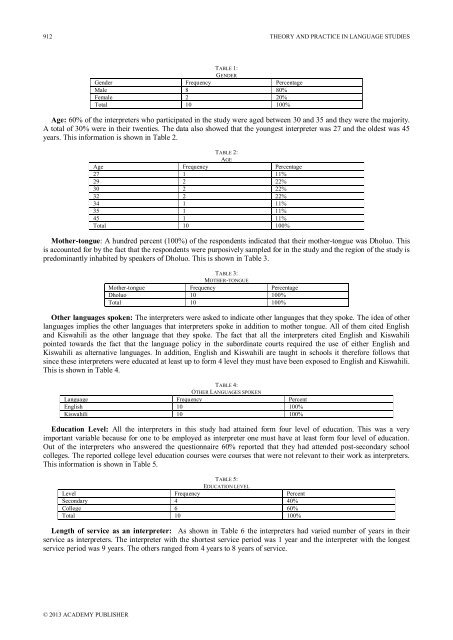Theory and Practice in Language Studies Contents - Academy ...
Theory and Practice in Language Studies Contents - Academy ...
Theory and Practice in Language Studies Contents - Academy ...
Create successful ePaper yourself
Turn your PDF publications into a flip-book with our unique Google optimized e-Paper software.
912 THEORY AND PRACTICE IN LANGUAGE STUDIESTABLE 1:GENDERGender Frequency PercentageMale 8 80%Female 2 20%Total 10 100%Age: 60% of the <strong>in</strong>terpreters who participated <strong>in</strong> the study were aged between 30 <strong>and</strong> 35 <strong>and</strong> they were the majority.A total of 30% were <strong>in</strong> their twenties. The data also showed that the youngest <strong>in</strong>terpreter was 27 <strong>and</strong> the oldest was 45years. This <strong>in</strong>formation is shown <strong>in</strong> Table 2.TABLE 2:AGEAge Frequency Percentage27 1 11%29 2 22%30 2 22%32 2 22%34 1 11%35 1 11%45 1 11%Total 10 100%Mother-tongue: A hundred percent (100%) of the respondents <strong>in</strong>dicated that their mother-tongue was Dholuo. Thisis accounted for by the fact that the respondents were purposively sampled for <strong>in</strong> the study <strong>and</strong> the region of the study ispredom<strong>in</strong>antly <strong>in</strong>habited by speakers of Dholuo. This is shown <strong>in</strong> Table 3.TABLE 3:MOTHER-TONGUEMother-tongue Frequency PercentageDholuo 10 100%Total 10 100%Other languages spoken: The <strong>in</strong>terpreters were asked to <strong>in</strong>dicate other languages that they spoke. The idea of otherlanguages implies the other languages that <strong>in</strong>terpreters spoke <strong>in</strong> addition to mother tongue. All of them cited English<strong>and</strong> Kiswahili as the other language that they spoke. The fact that all the <strong>in</strong>terpreters cited English <strong>and</strong> Kiswahilipo<strong>in</strong>ted towards the fact that the language policy <strong>in</strong> the subord<strong>in</strong>ate courts required the use of either English <strong>and</strong>Kiswahili as alternative languages. In addition, English <strong>and</strong> Kiswahili are taught <strong>in</strong> schools it therefore follows thats<strong>in</strong>ce these <strong>in</strong>terpreters were educated at least up to form 4 level they must have been exposed to English <strong>and</strong> Kiswahili.This is shown <strong>in</strong> Table 4.TABLE 4:OTHER LANGUAGES SPOKEN<strong>Language</strong> Frequency PercentEnglish 10 100%Kiswahili 10 100%Education Level: All the <strong>in</strong>terpreters <strong>in</strong> this study had atta<strong>in</strong>ed form four level of education. This was a veryimportant variable because for one to be employed as <strong>in</strong>terpreter one must have at least form four level of education.Out of the <strong>in</strong>terpreters who answered the questionnaire 60% reported that they had attended post-secondary schoolcolleges. The reported college level education courses were courses that were not relevant to their work as <strong>in</strong>terpreters.This <strong>in</strong>formation is shown <strong>in</strong> Table 5.TABLE 5:EDUCATION LEVELLevel Frequency PercentSecondary 4 40%College 6 60%Total 10 100%Length of service as an <strong>in</strong>terpreter: As shown <strong>in</strong> Table 6 the <strong>in</strong>terpreters had varied number of years <strong>in</strong> theirservice as <strong>in</strong>terpreters. The <strong>in</strong>terpreter with the shortest service period was 1 year <strong>and</strong> the <strong>in</strong>terpreter with the longestservice period was 9 years. The others ranged from 4 years to 8 years of service.© 2013 ACADEMY PUBLISHER
















